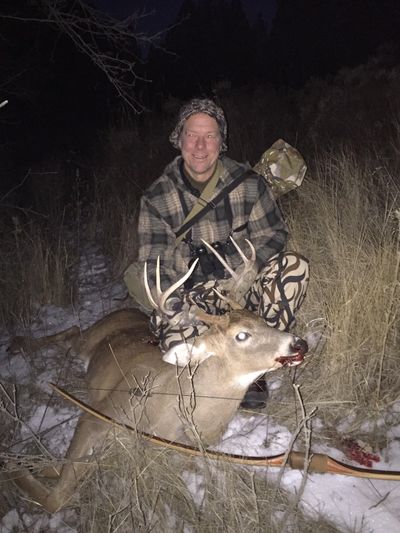With early archery season open, some hunters go primitive

A few years ago, just days before Thanksgiving, Jerry White leaned against a tree and watched a whitetail doe emerge from the forest.
About 10 yards away, the doe was close enough for White to get a shot off with his bow, carved by hand from a single piece of wood.
“I go to pull up and she stops,” White said. “And she all of a sudden hears my thumb brush against the fletching on my arrow … all of her ears swivel around and she turns around and walks out of range.”
Such is the life of a traditional bow hunter.
A subdiscipline of bow hunting, traditional bow hunters don’t use compound bows (a bow that uses levers and pulleys to assist the archer). That means it’s harder to accurately shoot far, requiring most traditional archers to get closer to their quarry.
White, the Spokane Riverkeeper, takes it a step further. He’s a disciple of a sub-subarchery discipline, primitive bow hunting.
Unlike laminated bows, his bows are carved from one piece of wood.
For White, that means he has to be within 20 yards of the animal to feel comfortable taking a shot. Although he grew up hunting with a rifle, the past decade in which he’s hunted with a traditional bow – and then a primitive bow – has changed how he hunts.
“I’ve learned more about whitetail deer in the last five years then I have in the previous 25 or 30 hunting with a rifle,” he said. “And a lot of that has to do with the fact that you’re hunting with a stick and a string.”
All hunting requires patience. But, archery – and specifically traditional and primitive archery – ups the ante.
“There have been so many times when I’ve been a hair’s breath from having a success and it doesn’t quite come together,” White said. “The primitive equipment really demands perseverance and patience. It actually demands that you really listen to the landscape in a way that is really rewarding.”
This year, he’s using a bow he made by hand under the tutelage of Jamie MacDonald, a British Columbia bowyer trained in the tradition of making English yew bows.
When White hunts with this primitive weapon, he feels connected to “the ancient human heritage” of the bow and arrow. In particular, he thinks about Ötzi the Iceman, a 5,300-year-old skeleton found in the Italian Alps in 1991. Ötzi was found with the remnants of a bow and 14 arrows, much like the gear White and others use to hunt today.
“There is something really cool about almost reaching back into history,” he said.
By reaching into history, White reconnects with something primal and important.
“As our society gets more and more removed from nature … traditional archery is a really amazing and beautiful way to connect yourself with the landscape and deepen your understanding of how everything works together,” White said. “It’s a really cool gateway into nature.”